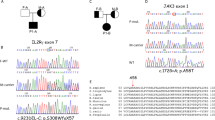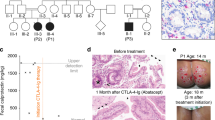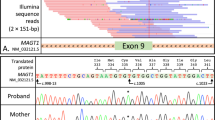Abstract
XCHROMOSOME-LINKED immunodeficiency with hyper-IgM (HIGM1, MIM number 308230) is a rare disorder characterized by recurrent bacterial infections, very low or absent IgG, IgA and IgE, and normal to increased IgM and IgD serum levels1–3. HIGM1 has been suggested to result from ineffective T-cell help for B cells4. We and others5–8 have identified a novel, TNF-related activation protein (TRAP) that is exclusively expressed on the surface of stimulated T cells6,8. TRAP, a type II transmembrane protein of Mr 33,000, is the physiological ligand for CD40 (refs 5–8). Crosslinking of CD40 on B cells induces, in the presence of lymphokines, immunoglobulin class switching from IgM to IgG, IgA or IgE5,9–11. Mapping of the TRAP gene to the X-chromosomal location q26.3–q27.1 (ref. 6) suggested a causal relationship to HIGM1, which had previously been assigned to Xq26 (refs 12–14). Here we present evidence that point mutations in the TRAP gene give rise to nonfunctional or defective expression of TRAP on the surface of T cells in patients with HIGM1. The resultant failure of TRAP to interact with CD40 on functionally intact B cells is responsible for the observed immunoglobulin isotype defect in HIGM1.
This is a preview of subscription content, access via your institution
Access options
Subscribe to this journal
Receive 51 print issues and online access
$199.00 per year
only $3.90 per issue
Buy this article
- Purchase on Springer Link
- Instant access to full article PDF
Prices may be subject to local taxes which are calculated during checkout
Similar content being viewed by others
References
Rosen, F. S., Kevy, S. V., Merler, E., Janeway, C. A. & Gitlin, D. Pediatrics 28, 182–195 (1961).
Burtin, P. Rev. Fr. Etud. clin. Biol. 6, 286–289 (1961).
Notarangelo, L. D., Duse, M. & Ugazio, A. G. Immunodef. Rev 3, 101–121 (1992).
Mayer, L. et al. New Engl. J. Med. 314, 409–413 (1986).
Armitage, R. J. et al. Nature 357, 80–82 (1992).
Graf, D., Korthäuer, U., Mages, H. W., Senger, G. & Kroczek, R. A. Eur. J. Immun. 22, 3191–3194 (1992).
Hollenbaugh, D. et al. EMBO J. 11, 4313–4321 (1992).
Spriggs, M. K. et al. J. exp. Med. 176, 1543–1550 (1992).
Jabara, H. H., Fu, S. M., Geha, R. S. & Vercelli, D. J. exp. Med. 172, 1861–1864 (1990).
Rousset, F., Garcia, E. & Banchereau, J. J. exp. Med. 173, 705–710 (1991).
Defrance, T. et al. J. exp. Med. 175, 671–682 (1992).
Mensink, E. J. B. M. et al. Hum. Genet. 76, 96–99 (1987).
Padayachee, M. et al. Genomlcs 14, 551–553 (1992).
Padayachee, M. et al. J. med. Genet. (in the press).
Bonifacino, J. S., Cosson, P., Shah, N. & Klausner, R. D. EMBO J. 10, 2783–2793 (1991).
Liu, Y. J. et al. Nature 342, 929–931 (1989).
Banchereau, J. & Rousset, F. Nature 353, 678–679 (1991).
Hermann, P. et al. Eur. J. Immun. (in the press).
Author information
Authors and Affiliations
Rights and permissions
About this article
Cite this article
Korthäuer, U., Graf, D., Mages, H. et al. Defective expression of T-cell CD40 ligand causes X-linked immunodeficiency with hyper-IgM. Nature 361, 539–541 (1993). https://doi.org/10.1038/361539a0
Received:
Accepted:
Issue Date:
DOI: https://doi.org/10.1038/361539a0
This article is cited by
-
A novel hemizygous CD40L mutation of X-linked hyper IgM syndromes and compound heterozygous DOCK8 mutations of hyper IgE syndromes in two Chinese families
Immunogenetics (2024)
-
CD40 Ligand Deficiency in Latin America: Clinical, Immunological, and Genetic Characteristics
Journal of Clinical Immunology (2022)
-
Complex preimplantation genetic tests for Robertsonian translocation, HLA, and X-linked hyper IgM syndrome caused by a novel mutation of CD40LG gene
Journal of Assisted Reproduction and Genetics (2020)
-
Primary Immunodeficiency Disorders Among North Indian Children
The Indian Journal of Pediatrics (2019)
-
Sex differences in vaccine-induced humoral immunity
Seminars in Immunopathology (2019)
Comments
By submitting a comment you agree to abide by our Terms and Community Guidelines. If you find something abusive or that does not comply with our terms or guidelines please flag it as inappropriate.



